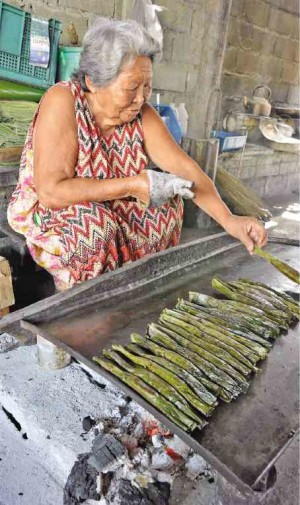Widow rises above ordinary with 2,000 ‘tupig’ per day

Nanay Patring, the oldest and most successful “tupig” maker of Mangatarem town in Pangasinan, cooks some of the hundreds of tupig she produces in a day in her shop in front of her house in the village of Umangan. —RAY ZAMBRANO
MANGATAREM, Pangasinan—At dawn, this town’s oldest and most prolific “tupig” maker, Patrocenio de Guzman, is already preparing the ingredients she needs for the hundreds of tupig she will cook for the day.
She would sit on a plastic stool beside a pile of newly opened coconuts and strip off their white meat with an improvised shredder. Then she would transfer the coconut strips into a large metal basin and mix these with other ingredients.
Tupig, a popular delicacy in Pangasinan province, is made of ground glutinous rice and coconut strips wrapped in banana leaves and cooked over charcoal.
“I started with just half a ‘ganta’ (approximately 0.75 kilograms) of glutinous rice,” said De Guzman, who prefers to be called by her nickname “Patring” because her parents baptized her using a man’s name.
De Guzman helps her sister-in-law cook tupig to augment the income that her husband earns as a bus conductor.
Fateful advice
One day, De Guzman said, her sister-in-law told her: “Why don’t you also start making tupig so that you will have money when you need it?”
At first she produced 75 pieces of tupig, which were sold quickly. She would soon find herself toiling late nights to produce more tupig to sell in the public market.
Currently, De Guzman produces up to 2,000 pieces of tupig a day with the help of her children and grandchildren. She no longer sells her produce in a makeshift stall. Buyers now come to her house in the village of Umangan here.
“I don’t run out of orders. Government officials, ‘balikbayan’ and traders come here to buy or to order,” De Guzman said. “I’ve lost track of where my products go,” she added.
She said some balikbayan order 1,000 pieces of tupig in one transaction. “They’d keep these in the freezer and even after six months, the tupig is still good,” she said.
During “Tupig Festival,” a sidelight of the town’s fiesta on Jan. 25, the town government ordered 5,000 pieces of tupig from De Guzman.
What makes her tupig different? Julian Def Sison IV, of the mayor’s office, said it is the texture. “You can taste the glutinous rice and you can feel the coconuts strips,” he said.
De Guzman said there is no secret ingredient, as some residents claimed. The secret, she said, is preparation.
“When it’s cold, tupig becomes hard if the glutinuous rice is grounded up,” she added.
The coconut strips are mixed with sugar to increase their moisture level before these are mixed with the rice paste. By 10 p.m., workers begin to wrap small amounts of the mixture in banana leaves and cook these until the morning.
De Guzman said it takes about an hour to cook 100 pieces of tupig. “You just have to be patient and industrious,” she said.
From making tupig, she was able to buy houses for her and her eight children that she raised alone after her husband died 30 years ago.














